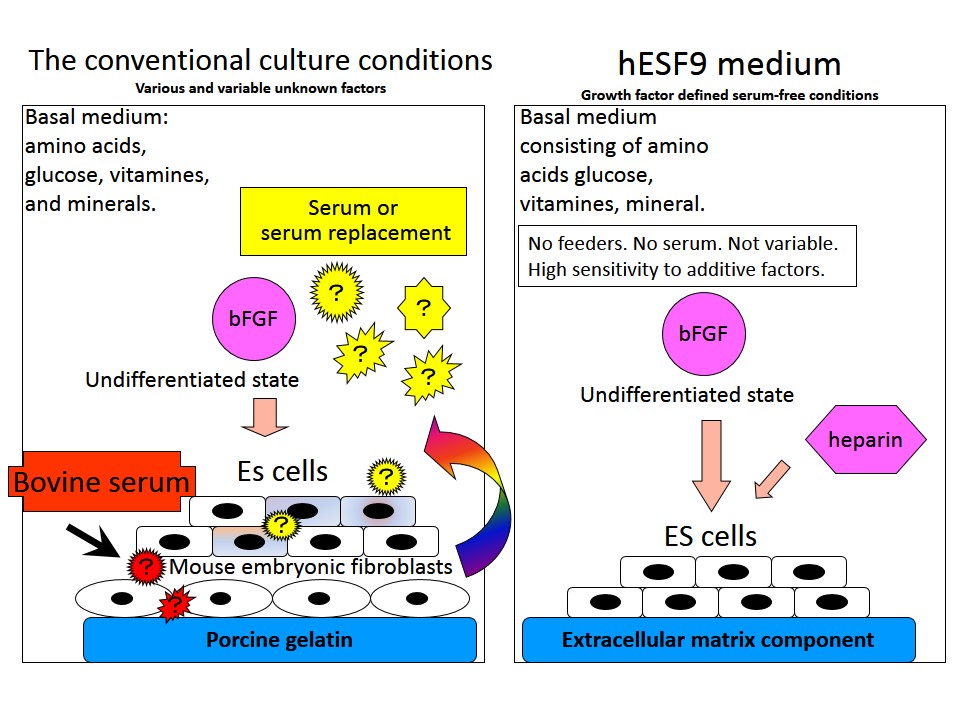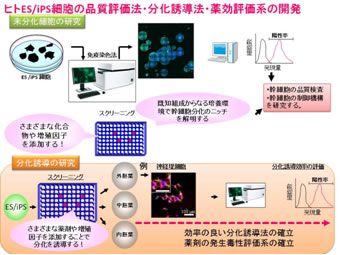HOME › Research and Resources › Research on Disease Bioresources › Laboratory of Stem Cell Cultures (LSCC)

Laboratory of Stem Cell Cultures (LSCC)
1. Key members
- Leader - Miho K Furue Ph.D., D.D.S.
- Project Researcher - Mika Suga Ph.D.
- Post doctoral fellows - Takayuki Fukuda Ph.D.
- Research assistants - Naoko Ueda,Liu Yu-Jung Ph.D.
- Secretary - Sawako kumamoto,Yuriko Okuda
2. Background and objectives
Human pluripotent stem cells (hPSCs), including embryonic stem cells (hESCs) and human induced pluripotent stem cells (hiPSCs) have great potential as a possible source of cells for cell-based medicine and also for other research applications, such as developmental biology and pharmaceutical research. To promote research for the practical application of hPSCs, we are developing methods to evaluate the quality of hPSCs, inspecting the cells by the developed methods for cell repository, and making distribution stocks of hiPSCs which have been donated to the JCRB Cell Bank. Further, we are developing practical chemical screening systems using hPSCs or their derived differentiated cells.

3. Overview of our research
I.Stem cell banking for pharmaceutical research
We culture and characterize human induced pluripotent stem cells (hiPSCs), donated to JCRB Cell Bank to make distribution stocks. As supplemental information of the cells, results of the analysis is available on the homepage of JCRB Cell Bank. From the point of view of applying human stem cells in drug discovery research, we are developing methods to evaluate stem cells. We continue to promote the standardization of basic techniques of cultivation technology, and we are supporting the activities for research infrastructure through cell culture training courses in collaboration with the Japanese Tissue Culture Association.
Human iPS cell line catalogue:http://cellbank.nibio.go.jp/english/cellsearch_e/
II. Development of evaluation methods for cell morphology of undifferentiated human pluripotent stem cells
It is difficult to maintain the undifferentiated state of human pluripotent stem cells (hPSCs) because of their differentiation potential or genetic instability. Therefore, characteristics of hPSCs should be routinely checked. Cell morphology is one of the important criterion to determine their characteristics. We are now developing methods to evaluate the cell morphology of hPSCs.
III.Development of derivation methods for anterior neural crest from human pluripotent stem cells
Previously, we have developed growth factor defined serum-free medium hESF9 (1), hESF9a (2,3), hESF9a2i(4), and hESF-FX (patent application) for culturing human pluripotent stem cells (hPSCs), and hESF10 (5) for culturing human mesenchymal stem cells. These culture conditions enable the accurate detection of the cellular signaling in stem cell niches (4, 6). We also previously developed an induction method for neural crest from mouse ES cells under the growth factor defined serum-free culture conditions in monolayer culture (7). Using these culture conditions, we are developing derivation methods for anterior neural crest from hPSCs to apply the cells to chemical screening.
1. Furue MK, Na J, Jackson JP, Okamoto T, Jones M, Baker D, Hata R, Moore HD, Sato JD, Andrews PW. Proceedings of the National Academy of Sciences of the United States of America 105:13409-14 (2008)
2. Jie Na, Miho K. Furue and Peter W. Andrews. Stem Cell Research 2010. Stem Cell Research 5(2):157-69 (2010)
3. Hayashi Y, Chan T, Warashina M, Fukuda M, Ariizumi T, Okabayashi K, Takayama N, Otsu M, Eto K, Furue MK, Michiue T, Ohnuma K, Nakauchi H, Asashima M. Plos One 5(11):e14099 (2010)
4. Kinehara M., Kawamura S., Tateyama D., Suga M., Matsumura H., Mimura S., Hirayama N., Hirata M., Uchio-Yamada K., Kohara A., Yanagihara K., Furue MK. Protein Kinase C Regulates Human Pluripotent Stem Cell Self-Renewal. Plos one., 8,1-13 (2013)
5. Mimura S, Kimura N, Hirata M, Tateyama D, Hayashida M, Umezawa A, Kohara A, Nikawa H, Okamoto T, Furue MK. Growth Factor-Defined Culture Medium for Human Mesenchymal Stem Cells. Int J Dev Biol. 55(2):181-7 (2011)
6. Kinehara M., Kawamura S., Mimura S., Suga M., Hamada A., Wakabayashi M., Nikawa H., and Furue K.M. Stem Cells and Development 2014 Jan 11. (2014) doi:10.1089/scd.2013.0424.
7. Yuko Aihara, Yohei Hayashi, Mitsuhi Hirata, Nobutaka Ariki, Shinsuke Shibata, Narihito Nagoshi, Mio Nakanishi, Kiyoshi Ohnuma, Masaki Warashina, Tatsuo Michiue, Hideho Uchiyama, Hideyuki Okano, Makoto Asashima and Miho Kusuda Furue. Int. J. Dev. Biol. 54: 1287 - 1294 (2010)

IV.Development of methods to differentiate human pluripotent stem cells into endoderm lineage
Human pluripotent stem cell (hPSC) -derived hepatocyte-like cells (HLCs) are expected to become tools for drug toxicity screening. However, hPSCs show variations in differentiation efficiencies into HLCs. A method to select a suitable line from many hPSC lines is required. We are developing a method for evaluating undifferentiated hPSC characteristics to predict cell differentiation efficiency into HLCs.

Contact:lsccnibio@nibio.go.jp



